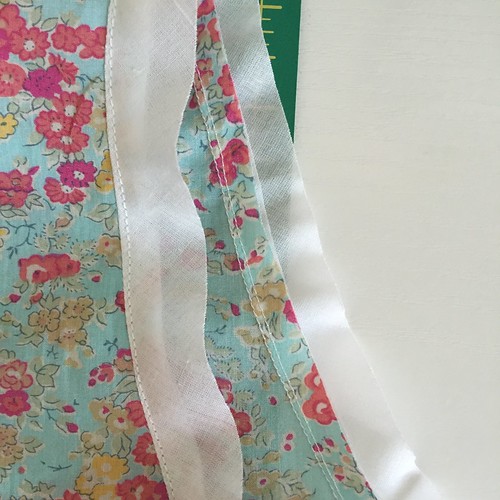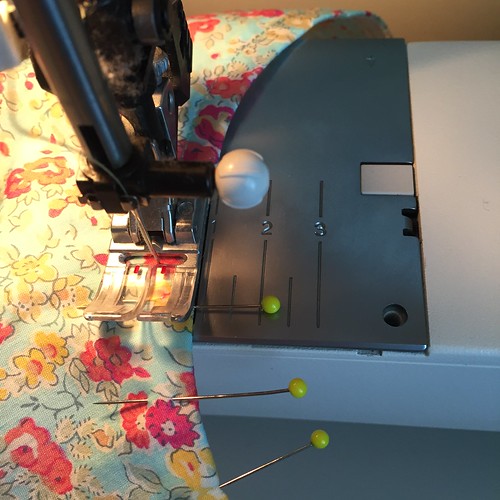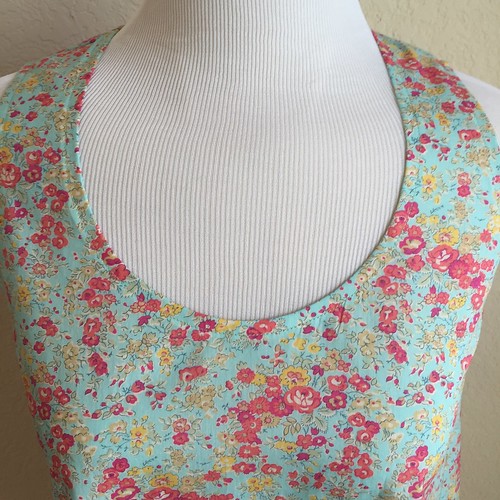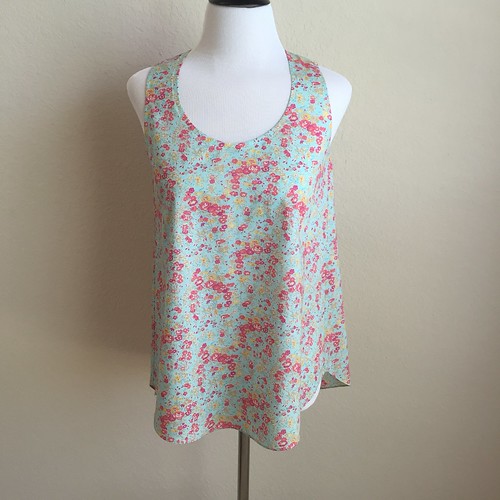After Monday’s
Wiksten Tank post, there was a question from a blog reader about the neckline. I realized that I had just been doing what I was taught years ago and had never really read the pattern. I took a look at the pattern and decided to show you all, step by step how I do the arm and neck edges (they’re sewn the same way). You will still need the pattern for the other steps in sewing this tank, and you’ll use the seam allowances listed in the pattern.
The pattern has you do the arm and neck edges in two steps: sew the bias facing to the edges and turn them and top stitch. I use about four steps (with some little sub-steps in between):
- Sew the bias facing strips to your neck and arm openings, right sides together, following the directions for seam allowance width in the pattern.
- Under stitch
- Trim the seam allowances
- Turn the bias strips to the inside and topstitch.
This is not a particularly fast technique, but if you’re patient and take your time, the edges will lie flat and look perfect. After you’ve done it a time or two, it does get faster.
Since I was finishing another Wiksten yesterday, I took a bunch of pictures to show how I did this.
I’ve already sewn the bias facing strips to the neck and arm edges, right sides together. I’ve also already under stitched in this photo. On the left is what my arm edge looks like from the right side and on the right, you can see the wrong side.
If you’ve never heard of under stitching before, it’s not difficult. Basically, after sewing your facing to your main project piece, you flip the facing away from your garment and topstitch the facing to the seam allowances. You aren’t trying to stitch in the ditch, but you are trying to get as close to the edge of the facing as possible (without falling in the “ditch”). I find that gently pulling the facing and the garment away from each other on either side of the presser foot, and periodically making sure my seam allowances are still flat underneath, makes it easier. (Don’t pull so hard that you stretch your bias edges.) Above, you can see the under stitching showing on the white facing strip on the left, and if you look at the wrong side of the arm edge, where you can see two rows of stitching very close together - the stitching on the left is the seam and the stitching on the right is the under stitching. The under stitching will not show on the right side when your garment is finished, but it makes it easier to turn the facing smoothly and it helps the edge to roll to the inside (so your facing doesn’t show when you wear the garment).
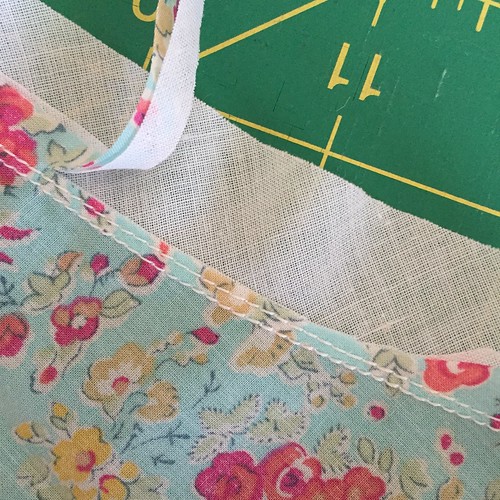
The next step is to trim the seam allowances. You do this for two reasons: to reduce bulk and to keep the seam allowances from tightening up your arm and neck openings. The first reason doesn’t really come into play with a lightweight fabric like Liberty’s Tana Lawn, but if you want your neck and arm openings to lie flat and not be too tight, you still need to trim your seam allowances. Remember, the seam allowance edge is slightly smaller than your opening edge, and unlike your facing strips the seam allowance isn’t entirely bias. Where the arm and neck edges are on the straight of grain, they will try to pull in. Theoretically, on a light weight fabric where bulk isn’t a concern, you could clip the edges to get them to release that pressure, but having clips along the edge could weaken your garment and lead to tears in the future. Since you have a double row of stitching around each opening (the original seam and the under stitching), you can trim very close to the under stitching and not worry about the integrity of the garment. When you trim, take your time and make sure the facing itself doesn’t get trimmed. You just want to trim the seam allowances, as close as you can to the under stitching line.
By the way, I tried not trimming the seam allowances on my first Liberty of London tank (back in March) and the neck and arms were way too tight. I ended up spending time with the seam ripper and undoing them to get back to this point so I could trim the seam allowances. Then I refinished the top and all was right with the world. Learn from my mistake and save yourself some time.
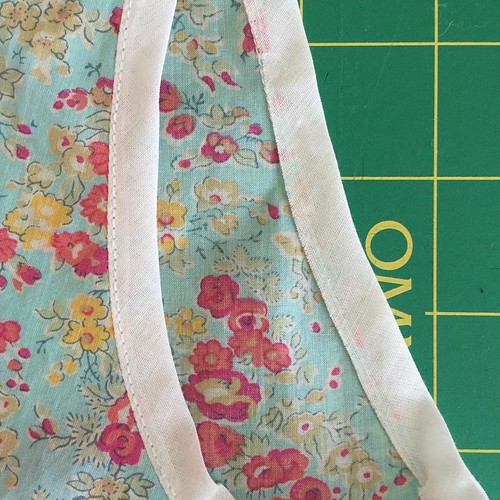
The next step is to go to the ironing board and start turning the bias facing strips to the inside. I do this in two steps and I actually discovered a way to make it easier with fabric glue when I was getting photos for this tutorial, so thanks blog! The first part of this is to turn the raw edges of the bias facing strips in. I like to line up the raw edge with the inner stitching line, so both the seam and the under stitching are covered on the inside and press a fold into the bias facing strip. Above, you can see this step completed. On the left is the right side of the garment and on the right is the wrong side of the garment. You can still see the line of under stitching from the right side at this point, but both lines of stitching are covered by the bias facing on the wrong side. Compare this to the first photo if you’re confused about what you’re seeing.
As I was trying to do this and get photos of the process, I used a
fabric glue stick to hold the raw edges in place. I just lightly dabbed some glue on the stitching on the wrong side of the garment, lined up the raw edges as I described above and pressed with my iron WITH THE STEAM OFF. (If the steam was on, it could dissolve the glue, which would pretty much defeat my purpose.) Using the glue was like having an extra hand and definitely saved time. I’ll be using glue again!
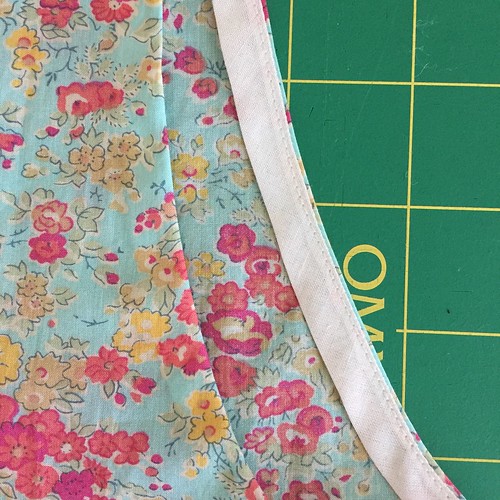
The next step is to turn the bias facing all the way to the inside of the garment. I didn’t use the glue for this second turn. Since you under stitched earlier, the facing will turn with just the tiniest bit of your main garment piece to the back, keeping the facing from showing on the outside. In the picture above, the right side of the garment is to the left and the wrong side is to the right. You can now see the under stitching on the wrong side of the garment, and if you look at that edge, you can see a tiny line of the outer garment fabric, just outside the bias facing strip. You want that. If you had folded the bias facing strip exactly on the seam line, the edge of the facing strip would barely show from the right side of the garment. Under stitching forces the the garment edge to follow the bias facing strip around that fold just a little bit, which makes things look neater.
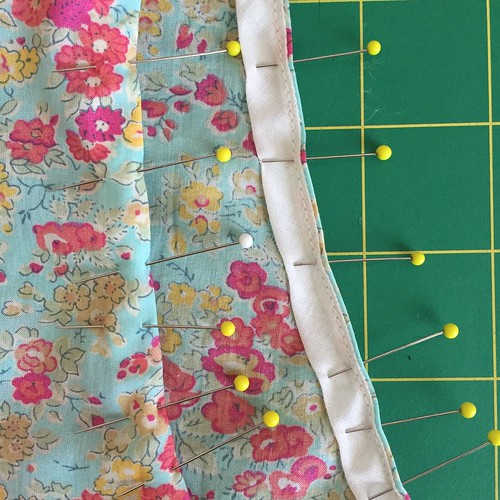
At this point you need to pin the bias facings to the inside. (Yes, you’ve already pressed them, but I always pin before I sew just to make sure things don’t get weird while I’m sewing.) I use lots of pins because I’d rather sew slowly than have to redo this seam. It’s going to show from the right side, so you really don’t want to have to start and stop.
Then you sew. Sew with the right side facing up and keep your distance from the edge consistent. This line of sewing will show on your finished garment - you don’t want bobbles and wobbles. Take your time on this step. You need to catch the fold of the bias facing strip on the inside, so before you start sewing, use a ruler and see where you need to put the garment edge.
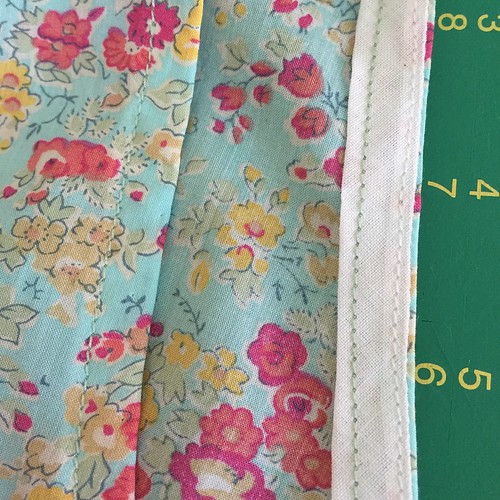
Here’s what the edge should look like once it’s all sewn. Again, the right side is on the left and the wrong side is on the right. You can see that I’m not quite all the way over to the edge of the fold of the bias facing, but it’s close enough that it’s not going to flap around, and my stitching from the right side is evenly spaced from the edge, all the way around the opening. Also, I used a thread to match my fabric on this last bit of stitching (and the hem, which is already finished). I sewed the side and shoulder seams, attached the bias facing strips and under stitched them with white thread because none of that will show from the right side of the garment. I did this because I stitched three Wiksten tanks at once and then swapped to matching thread for hems and arm and neck opening top stitching. If I was only sewing one tank at a time, all the thread would have matched the main fabric.
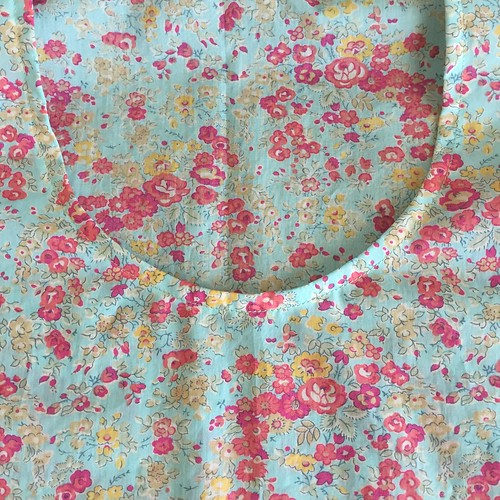
After top stitching the arm and neck openings, my neck edge isn’t quite laying flat. Once I hit it with the steam iron, the bias relaxes into the shape of the curve…
…and everything lies flat!
Now I have another finished Wiksten Tank!
Just a side note, the Wiksten Tank pattern calls for using your main fabric for the bias facing strips. On these pale colored tanks I’ve done, I’ve used a white cotton batiste instead of the Liberty of London Tana Lawn. By using another fabric for these facings, I only need to buy a yard of Liberty to get a tank top in the XS size. That’s why my bias facings are white, instead of matching my main floral fabric.
Labels: sewing, Tutorials

